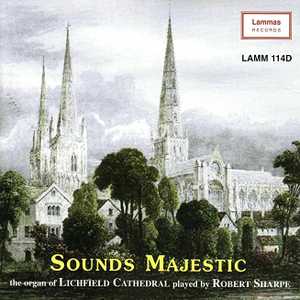Sounds Majestic

The organ of Lichfield Cathedral played by Robert Sharpe
Méditation from Symphonie I Charles-Marie Widor
Allegro Risoluto from Symphonie II Louis Vierne
Cortège et Litanie Marcel Dupré
Folk Tune Percy Whitlock
Introduction and Passacaglia W G Alcock
'Dorian' Toccata and Fugue in D minor J S Bach
Étoile du Soir Louis Vierne
Church Parade Richard Lloyd
Knightsbridge March Eric Coates arr. Sharpe
Total playing time 70m 28s
Sounds Majestic
The organ of Lichfield Cathedral played by Robert Sharpe
This recording of the magnificent Hill organ in Lichfield Cathedral was made shortly before the dismantling of the instrument by Harrison & Harrison for a major overhaul. We hope that you, the listener, will enjoy the programme of music recorded especially to show the organ's renowned range of colour and power.
Gordon Jacob's Festal Flourish features fanfare passages for the organ's famous Tuba Mirabilis stop (positioned in the north transept case). After a quieter middle section based on the opening material, the piece builds to a stately conclusion.
Charles-Marie Widor is known chiefly for the famous Toccata which is the finale of the fifth of his ten 'Symphonies' for organ. The last set of these were conceived as entities but the earlier ones are really just suites of contrasting pieces. Méditation from the first symphonie is a gentle movement in E flat minor; a mellifluous melody (for Flûte Harmonique) is accompanied on string stops before being joined by a counter-melody on the pedals.
Louis Vierne was a younger contemporary of Widor's and organist of Notre Dame in Paris. His six organ symphonies follow a similar model to Widor's but are more unified and somewhat more colourful in their harmonic language.
Allegro Risoluto which opens the second symphonie is a magnificent, dark, swaggering piece in E minor; the movement ends triumphally on the tutti, with a blazing major cadence.
Marcel Dupré was Widor's successor at the church of Saint Sulpice in Paris; before his appointment there he spent a short period of time as acting organist at Notre Dame during Vierne's absence. Dupré's music is highly disciplined and often rigorously contrapuntal; his virtuoso technique was legendary and some of his works stretch the player (and instrument) to previously unknown limits. Cortège et Litanie however, is an early, gentler piece. Originally conceived for orchestra, the opening material gives way to a quasi-plainchant theme (heard first on the Flûte Harmonique). As the work develops, this theme is combined with the earlier one; a gradual crescendo then leads to the final thrilling toccata section over a tonic pedal.
Percy Whitlock was organist of the Bournemouth Pavilion as well as holding a number of church positions; he wrote extensively for the organ and Folk Tune is from the collection Five Short Pieces. Its haunting melody is heard first on a flute and then a reed stop; the theme is then developed but soon returns to the flute before the hushed ending over the low thirty-two feet pedal.
W G Alcock's reputation as a performer was formidable. He was Sub Organist at Westminster Abbey and then Organist at Salisbury Cathedral. His mighty Introduction and Passacaglia is dedicated to Harold Darke, a renowned Bach player. In a more Romantic vein, Alcock's work is clearly inspired by Bach's Passacaglia; the soft ending and gradual crescendo are a reminder of the style of Bach playing used by Darke and others on Britain's great Romantic organs. The piece is a tour de force of counterpoint and reaches a mighty conclusion with the Tuba (heard at the outset) coupled to the full organ.
W H Harris spent a short time after the first world war as Assistant Organist at Lichfield Cathedral before moving to Oxford and then St George's Chapel, Windsor. This short Prelude from Four Short Pieces was written in Bach's church in Leipzig, St Thomas's. The influence of Bach is evident in its elegantly crafted phrases and flowing lines.
J S Bach's 'Dorian' Toccata and Fugue in D minor features the choruses of the Great and Swell/Choir divisions of the organ in dialogue. On this recording, a scheme of registration something like that used in the past by Darke, Harris and Alcock on the great Romantic instruments of Britain has been adopted for the Fugue; a gradual crescendo to the full Swell and Great.
Vierne produced a cycle of 24 Pièces de Fantaisie in addition to his organ symphonies. These use a highly developed impressionistic harmonic style to create the mood suggested by their picturesque titles. In Etoile du Soir, a single flute stop at the beginning leads to a canonic middle section (right hand and pedals with a rippling left hand accompaniment) then a final slower section again all illustrating the twinkling effect of the evening star-light.
Richard Lloyd began his musical training as a chorister at Lichfield Cathedral under the well-known organist of that time, Ambrose Porter. Although perhaps best known for his choral works, Richard Lloyd has written a number of organ pieces in his colourful style. Church Parade has a stately, processional feel based around the trumpet-like opening motif.
Organ transcriptions of orchestral music have become popular in more recent years, especially when they transfer to the resources of a large instrument as well as Eric Coates's Knightsbridge March, the last movement of his London Suite. Its 'big tunes' and fanfares are an ideal opportunity for an airing of some of the Lichfield organ's 'cinema' effects.
Robert Sharpe - Lichfield 1999
©1999 LAMMAS RECORDS
Recorded and edited by Lance Andrews